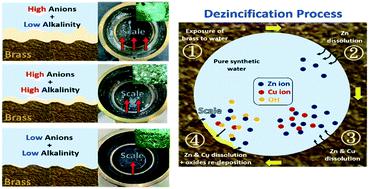当前位置:
X-MOL 学术
›
Environ. Sci.: Water Res. Technol.
›
论文详情
Our official English website, www.x-mol.net, welcomes your feedback! (Note: you will need to create a separate account there.)
Dezincification of brass water meters in a long-term study: effects of anions, alkalinity, and residual chlorine
Environmental Science: Water Research & Technology ( IF 5 ) Pub Date : 2021-07-15 , DOI: 10.1039/d1ew00351h Shu-Ju Chao , Ming-Han Tsai , Rui-Pei Yu , Lap-Cuong Hua , Chi-Chang Hu , Chihpin Huang
Environmental Science: Water Research & Technology ( IF 5 ) Pub Date : 2021-07-15 , DOI: 10.1039/d1ew00351h Shu-Ju Chao , Ming-Han Tsai , Rui-Pei Yu , Lap-Cuong Hua , Chi-Chang Hu , Chihpin Huang

|
The dezincification of brass water meters in a water distribution system is affected by tap water characteristics. However, the effects of mixed water quality on corrosion and scale formation on the behaviour of brass water meters have remained unclear. This study investigated the long-term impact of tap water characteristics on the brass dezincification of commercial water meters, using a household-simulated circulating pipeline system. The effect of water anions, alkalinity, and residual chlorine on dezincification and corrosion of such brass water meters were quantitatively and electrochemically examined for over a period of 376 days. The results show that water meters suffer the most severe dezincification when the tap water has a high level of anions (SO42−: 120 mg L−1 and Cl−: 60 mg L−1) and low alkalinity (120 mg L−1 as CaCO3). Under such conditions, a considerable amount of zinc is leached, amounting to 146–153 mg L−1 over 376 days, accompanied by high corrosion rates of 42.2–45.8 μm per year. Exposure to water with high anionic concentrations and low alkalinity also results in a positive shift of 15 to 50 mV in the corrosion potential of chips of scaled brass, leading to heavy scale formation. The majority of Zn (∼50%) in the scale was demonstrated by ICP-OES and SEM/EDS. The data obtained from XPS suggest that scales of ZnCO3/Zn(OH)2 formed as a result of the long-term dezincification of brass. By contrast, minor dezincification was observed when the water meters were exposed to water of low anionic concentrations (SO42−: 60 mg L−1 and Cl−: 6 mg L−1), low alkalinity (120 mg L−1 as CaCO3), and low residual chlorine (0.2 mg L−1 as Cl2), even after 376 days. Under these conditions, the accumulative amount of zinc leaching and the corrosion rate were only 105 mg L−1 and 13.2 μm per year, which are significantly lower than those obtained in the high anion concentration and low alkalinity situations. This study provides a further insight into how tap water characteristics impact the long-term brass dezincification of water meters, which benefits water utilities to forecast scale formation under specific tap water conditions.
中文翻译:

长期研究中黄铜水表的脱锌:阴离子、碱度和余氯的影响
配水系统中黄铜水表的脱锌受自来水特性的影响。然而,混合水质对黄铜水表性能的腐蚀和水垢形成的影响仍不清楚。本研究使用家庭模拟循环管道系统调查自来水特性对商用水表黄铜脱锌的长期影响。水阴离子、碱度和余氯对黄铜水表脱锌和腐蚀的影响进行了 376 天的定量和电化学检测。结果表明,当自来水中阴离子含量高(SO 4 2- : 120 mg L -1和 Cl -:60 mg L -1)和低碱度(120 mg L -1作为 CaCO 3)。在这种条件下,大量的锌被浸出,在 376 天内达到 146-153 mg L -1,伴随着每年 42.2-45.8 μm 的高腐蚀速率。暴露于高阴离子浓度和低碱度的水中也会导致氧化黄铜碎片的腐蚀电位正移 15 至 50 mV,从而导致形成大量水垢。ICP-OES 和 SEM/EDS 证明了鳞片中的大部分 Zn(~50%)。从 XPS 获得的数据表明 ZnCO 3 /Zn(OH) 2 的尺度由于黄铜长期脱锌而形成。相比之下,当水表暴露于低阴离子浓度(SO 4 2- : 60 mg L -1和 Cl - : 6 mg L -1)、低碱度(120 mg L -1作为CaCO 3 ) 和低残留氯(0.2 mg L -1作为 Cl 2),即使在 376 天后也是如此。在这些条件下,锌的累积浸出量和腐蚀速率仅为105 mg L -1和 13.2 μm/年,明显低于在高阴离子浓度和低碱度情况下获得的值。这项研究进一步深入了解自来水特性如何影响水表的长期黄铜脱锌,这有利于自来水公司预测特定自来水条件下的水垢形成。
更新日期:2021-07-30
中文翻译:

长期研究中黄铜水表的脱锌:阴离子、碱度和余氯的影响
配水系统中黄铜水表的脱锌受自来水特性的影响。然而,混合水质对黄铜水表性能的腐蚀和水垢形成的影响仍不清楚。本研究使用家庭模拟循环管道系统调查自来水特性对商用水表黄铜脱锌的长期影响。水阴离子、碱度和余氯对黄铜水表脱锌和腐蚀的影响进行了 376 天的定量和电化学检测。结果表明,当自来水中阴离子含量高(SO 4 2- : 120 mg L -1和 Cl -:60 mg L -1)和低碱度(120 mg L -1作为 CaCO 3)。在这种条件下,大量的锌被浸出,在 376 天内达到 146-153 mg L -1,伴随着每年 42.2-45.8 μm 的高腐蚀速率。暴露于高阴离子浓度和低碱度的水中也会导致氧化黄铜碎片的腐蚀电位正移 15 至 50 mV,从而导致形成大量水垢。ICP-OES 和 SEM/EDS 证明了鳞片中的大部分 Zn(~50%)。从 XPS 获得的数据表明 ZnCO 3 /Zn(OH) 2 的尺度由于黄铜长期脱锌而形成。相比之下,当水表暴露于低阴离子浓度(SO 4 2- : 60 mg L -1和 Cl - : 6 mg L -1)、低碱度(120 mg L -1作为CaCO 3 ) 和低残留氯(0.2 mg L -1作为 Cl 2),即使在 376 天后也是如此。在这些条件下,锌的累积浸出量和腐蚀速率仅为105 mg L -1和 13.2 μm/年,明显低于在高阴离子浓度和低碱度情况下获得的值。这项研究进一步深入了解自来水特性如何影响水表的长期黄铜脱锌,这有利于自来水公司预测特定自来水条件下的水垢形成。



























 京公网安备 11010802027423号
京公网安备 11010802027423号